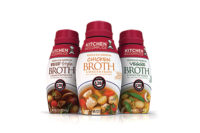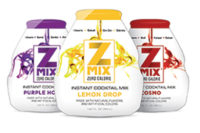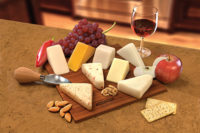Top Soup Trends in 2015
Manufacturers must address health, convenience and flavor trends to grow category sales.




What’s the recipe for success for soup and side dish manufacturers? Some of the ingredients already are there: more consumers are eating at home and they don’t want to cook from scratch. Yet manufacturers also must address health, convenience and flavor trends if they want to grow category sales.
After years of moderate declines between 2008 and 2011 and slow growth between 2011 and 2013, sales of pre-packaged soup are expected to continue growing slowly between 2013 and 2018, from $6.9 billion to $8 billion.
RTE wet soups lead the market with $2.1 billion in 2013 for 31.2% share, ahead of condensed wet soups, which sold $1.8 billion in 2013 for 26.2% share. Meanwhile, dry soup makes up 23.8% share with $1.6 billion in 2013, followed by wet broth/stock ($1 billion, 14.8% share) and refrigerated/frozen fresh soup ($279 million, 4.1% share).
Mintel, a global market intelligence agency, forecasts that the US soup market will grow slowly between 2013 and 2019, but brands can help spur growth by offering more better-for-you soups, expanded flavor varieties, and more convenient packaging that allows for heating and eating from the same container and easy consumption.
The slow economic rebound continues to force many consumers to prepare meals at home, and store-bought soup represents a relatively affordable meal solution (80% of respondents agree) for consumers who are still feeling the impact of the recession. Unemployment has declined over 2013 but remained steady in early 2014, and many job seekers have given up looking for work, and consumer confidence remains volatile from month to month, underscoring the anxiety many consumers feel about the economy and their own spending power, which means that soup brands should use affordability as at least one element of their marketing strategies.
Also factoring into sales of pre-packaged soup are innovations in flavor, convenience, and nutrition. Progresso recently launched its Artisan brand line, said to contain fresh ingredients in flavors such as Rustic Tomato with Chicken & Dumplings; Campbell’s Soup on the Go features microwaveable, sippable containers; and Amy’s Kitchen’s Light in Sodium soup range offers low-sodium versions of its regular soups.
Nearly two-thirds of respondents report buying condensed canned/boxed/carton soup for anyone in the household in the last six months, while more than half report buying RTE canned/boxed/carton soup and RTE broth. Condensed wet soup benefits from multiple uses, from soup itself (requiring the addition of water or milk during heating) to a base ingredient for other home-cooked dishes. Similarly, RTE broth can be eaten alone as a warming, sippable soup or used as a base for other dishes. Meanwhile, RTE wet soup makes for a fast and easy meal, requiring no additional water or milk to heat and eat. Fewer than half of respondents report buying other types of soup for anyone in the household, including bouillon cubes, dry soup, RTE hot soup, RTE refrigerated soup, soup kits and frozen soup.
More than half of respondents who buy soup for themselves report eating soup for lunch. For busy consumers, there is often little time or opportunity to prepare lunch, which means time-saving products such as pre-packaged soup constitute a good lunchtime solution.
Fewer than half of respondents report eating soup for dinner or as part of dinner, indicating that brands can do more to position their products as good dinner options from offering recipes that call for their products to suggestions for side dishes such as salad or bread to round out a dinner.
Only 14% of respondents report eating soup as a snack between meals.This indicates that most consumers do not view soup as good for snacking, possibly because soup is not always as easy to open and eat as other snack foods such as chips or candy. Some brands have made convenience a key attribute to facilitate snacking or eating on the go, such as Campbell’s Soup on the Go, which grew 39.6% between Dec. 30, 2012, and Dec. 29, 2013, reaching $43 million.
Some 56% of respondents who buy soup for themselves report eating soup to satisfy hunger, a good result for the market because it indicates that many buyers find soup filling. Some 56% also report eating it to warm up during cold weather, indicating that for many consumers soup is a seasonal dish. More than a third report eating soup because they were craving it, and more than a third report eating it because it is convenient.
Respondents report most interest in full serving of vegetables Nearly nine in 10 respondents who buy soup for the household report any interest (interest in and willingness to pay more for or interest in but not willing to pay more for) in soups with a full serving, or more, of vegetables. Many soups are high in vegetable content, although not all contain a full serving of vegetables, suggesting that adding more vegetables will appeal to those for whom soup is a source of vegetable intake.
Eight in 10 respondents report any interest in low-sodium soups. Sodium content is a significant concern for many buyers, and many brands offer low-sodium versions of their regular soups, although low-sodium brands run the risk of consumer perceptions that they sacrifice flavor. Focusing on other spices in low-sodium soups, such as curry or rosemary, may help low-sodium brands persuade buyers that flavor is still the main component in their products.
Close to eight in 10 respondents report any interest in soups with added vitamins and minerals and soups with high fiber. Brands that help users get the nutritional content they require through supplemental ingredients such as these will likely resonate among consumers looking for BFY (better-for-you) soups. More than three quarters of respondents report any interest in all-natural/organic soup ingredients. Consumers often perceive all-natural/organic foods to be better for their health than regular foods, a perception that all-natural/ organic brands can leverage to drive sales.
A third of respondents who do not buy soup for the household say they do not because they prefer homemade soup. A number of brands have rolled out products that combat the perception that pre-packaged soups compare unfavorably with homemade soup, such as Campbell’s Homestyle and Progresso Artisan, which incorporate wholesome ingredients and no preservatives.
Overall, it appears that slow market growth stems from a number of factors, including the perception among many consumers that while soup is a relatively healthy meal, soups that contain high amounts of sodium, artificial ingredients, and/or preservatives actually may pose a health risk. This means that—in this age of hyper-scrutiny and quick access to health and nutritional information—soup brands can no longer rely on their wholesome image to sell their products.
Instead, brands must take extra steps to burnish their nutritional image, such as adding more vegetables or supplemental ingredients such as vitamins and minerals or extra fiber. Brands also must do more to expand the flavor varieties of their products, borrowing from the cuisine of other cultures to offer more exotic soups, adding soups deriving from traditional sauces, and staying on top of food trends to provide soups that satisfy the ever-changing tastes of consumers.
Not surprisingly, there also is a “to-do” list for side dish manufacturers looking to grow category sales.
For the record, Mintel combines the prepared meal and side dish categories. Mintel estimates total retail sales of prepared meals and side dishes reached $9.9 billion in 2013, at current prices. The category declined 4% from 2008-13 as consumers prefer products with natural ingredients, and better-for-you claims. Within the category, refrigerated meals and side dishes improved their respective sales from 2008-13; however, their sales were not enough to offset sharp declines within the much larger frozen single-serve and multi-serve meal segments.
The overall category is expected to decline another 5% from 2013-18, reaching $9.5 billion, at current prices. Manufacturers’ abilities to promote the convenience of these products, meet consumer preferences for more natural and nutritional products, and segment products based on consumer need, can all help contribute to future growth.
The only two prepared meal and side dish segments to experience sales increases during the past five years were the refrigerated segments. The refrigerated meals and refrigerated side dishes segments represent just 22% of the overall category, collectively, but experienced sales increases of 10.5% and 4.9%, respectively, from2011-13. Of note, Bob Evans’ sales increased nearly 7% from 2013 reaching $221.8 million, as a result of sales of its homestyle refrigerated side dishes.
Frozen side dishes, which represent the smallest share of the market at 3.3%, declined nearly 8% from 2011-13, reaching sales of $325 million. The smaller format of many of these items lends themselves to snacking occasions which could help the segment; however, these items still struggle to stand out against frozen meals that come pre-packaged with side dishes.
Frozen meals have the highest household penetration rate with 73% of households indicating a purchase of single-serve or multi-serve frozen meals within the past six months. In comparison, slightly more than one third (35%) have purchased any type of refrigerated meals, and 48% have purchased any type of side dishes. The convenience of these items, and their versatility across meal occasions, are two reasons for their high household purchase, though there is room to improve their taste with better ingredients and quality.
Single-serve options are more popular among households, compared to multi-serve options, due in part to a decline in household size, as well as interest in single-serve options for controlling portion size and snacking. Compared to women, men are significantly more likely to have purchased refrigerated meals (41% of men, 31% of women), as well as frozen side dishes (39% of men, 35% of women). Past purchases of both prepared meals and side dishes tend to skew toward consumers aged 25-44.
Convenience and ease of use are the top reasons buyers of prepared meals and side dishes make such purchases. Some 76% purchase prepared meals or sides because they are useful to have on hand when they don’t want to cook, while 72% indicate these products are quicker than preparing food from scratch.
Prepared meals and side dish purchasers most often consider reduced claims and added nutrition when buying these items. Some 40% of consumers who use prepared meals and side dishes consider products with reduced fat or calories and 38% look for all natural ingredients, a claim that has grown steadily from 2009-14.
Compared to older purchasers, younger purchasers, specifically those aged 18-44, are more likely to consider ingredient claims such as high protein and whole grain, as well as products for specific diets, including vegetarian, gluten- and dairy-free options. Although consumers are motivated by convenience when purchasing prepared meals and side dishes, products with better-for-you claims can make it easier for consumers aspiring to make better eating decisions.
The leading factors that would influence consumers to purchase more prepared meals and side dishes are natural ingredients (39%), and higher-quality or gourmet items (35%). Usability and value-related factors also are most important to consumers.
Women are significantly more likely than men to cite factors related to ingredients as motivators for increased purchase of prepared meals and side dishes. Some 43% of women indicate natural ingredients would influence them to purchase more of these items, compared to 34% of men, while 21% indicate a limited number of ingredients would be an influence, compared to 14% of men.
Consumers aged 18-24 are least likely to indicate higher quality or gourmet items would influence them to purchase more prepared meals and side dishes (27%). The higher price point of these items, combined with lower household income among younger consumers, indicates they are not willing to splurge on gourmet options.
Source: Soup-US-April 2014
Source: Prepared Meals and Side Dishes-
US-May 2014
Amy Kraushaar is US Category Manager,
Food & Drink and Foodservice, at Mintel.
Amanda Topper is a food analyst at Mintel.
Looking for a reprint of this article?
From high-res PDFs to custom plaques, order your copy today!







